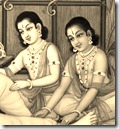 “The two youths, one dark-skinned and one fair, are treasures of beauty. It appears that Lord Brahma has taken all the beauty in the world and placed it in them.” (Janaki Mangala, 32) “The two youths, one dark-skinned and one fair, are treasures of beauty. It appears that Lord Brahma has taken all the beauty in the world and placed it in them.” (Janaki Mangala, 32)
syāmala gaura kisora manoharatā nidhi |
suṣamā sakala sakeli manahum̐ birace bidhi ||
As if you have found a treasure chest full of the most beautiful objects in the world, watching Lord Rama leave along with His younger brother Lakshmana brought so much joy to the eyes. Any chance to get a glimpse at these sweet boys was time well spent, as the material conditions have never been able to bring about such a benefit. The eyes are provided for a reason, and without the proper target to gaze upon the enchantment of material allures can lead us astray, in the process giving the eyes a bad name. With Dasharatha’s two sons leaving with the sage Vishvamitra, however, it seemed as if all the beauty in the world had been stored in one place. That same beauty is available to the eyes of the mind to feast on through the sacred works of Goswami Tulsidas.
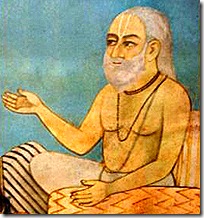 King Dasharatha’s sons are the Supreme Lord and His support systems respectively. Why would God need support? It is the soul’s dharma to serve. In general, in the perverted state the individual living being seeks out the role of lord or master, when in reality they are ideally suited to be servant. Think of a high school production of a play, where the different acts represent the timeline through life. Every conditioned being is trying to audition for the leading role of controller, the person responsible for creation, maintenance and destruction. No one wants to try out for the role of servant, though characteristically everyone is properly suited for it. King Dasharatha’s sons are the Supreme Lord and His support systems respectively. Why would God need support? It is the soul’s dharma to serve. In general, in the perverted state the individual living being seeks out the role of lord or master, when in reality they are ideally suited to be servant. Think of a high school production of a play, where the different acts represent the timeline through life. Every conditioned being is trying to audition for the leading role of controller, the person responsible for creation, maintenance and destruction. No one wants to try out for the role of servant, though characteristically everyone is properly suited for it.
The Lord’s younger brother Lakshmana, who is always His support system, has no interest in being master. He is already the leader of the disciplic succession of spiritual instruction, which teaches the many fragments of spirit their ideal condition, but he is always at the helm ready to provide service. As he can never disassociate from his dharma, he is considered the exemplary living entity, someone who is worshipable by his acts. Lakshmana is glorious and so dedicated to his service that not even Rama can stop him. Though God is the Supreme Controller capable of defying the law of gravity and controlling every outcome to events, He does not stand in the way of pure devotion that is inspired without motivation and without interruption.
In His spiritual manifestation as Lakshmana, God’s primary supporter has a fair complexion. The Supreme Lord, on the other hand, is darker. In some traditions the personal form of the Supreme Lord is denied, or it is taken to be subordinate to His impersonal feature. “Just as the living entities accept bodies and then reject them, so the Supreme Lord must follow the same tact, even when He appears before our very eyes.” This logic is flawed, as even the Vedas don’t support it. Impersonalism defined as a scientific discipline originates in the Vedas, the oldest scriptures for mankind. Every type of religious system and every system of maintenance descends from the original word of God handed down to Lord Brahma at the beginning of creation.
Yet only in the original system is the proper understanding of God as a person revealed. That personal feature has specific attributes that follow the different personal expansions. In the Vaishnava traditions it is agreed that Lord Vishnu is the original Personality of Godhead. Though some lines of disciplic succession take Lord Krishna to be the original and others Lord Rama, in any case there is no difference because Vishnu, Krishna, and Rama are practically the same person. The Vishnu-avataras are the expansions of the original personality, so they are equal to one another. Their spiritual manifestations are varied slightly, but in their original features they possess a shyama color.
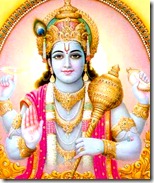 Shyama is dark. It can refer to dark blue or even green sometimes. The shyama color is like the tamala tree, of which very few are still left on this earth. Shyama is also like the color of the atasi flower or the raincloud that is just about to start pouring down its water. Generally, dark colored skin is not as visually appealing as fair-colored skin, but with the Supreme Lord His shyama complexion is still beautiful. For this reason He is also addressed by the name of Shyamasundara, which more specifically refers to His form as Shri Krishna. Shyama is dark. It can refer to dark blue or even green sometimes. The shyama color is like the tamala tree, of which very few are still left on this earth. Shyama is also like the color of the atasi flower or the raincloud that is just about to start pouring down its water. Generally, dark colored skin is not as visually appealing as fair-colored skin, but with the Supreme Lord His shyama complexion is still beautiful. For this reason He is also addressed by the name of Shyamasundara, which more specifically refers to His form as Shri Krishna.
With King Dasharatha, two of his sons were dark-skinned and two were fair. Bharata and Rama were of the darker shade and Lakshmana and Shatrughna were lighter. They were all either directly Vishnu or expansions of Him, so they were not lacking anything in beauty. In the above referenced verse from the Janaki Mangala, Goswami Tulsidas is specifically referring to the beauty of Rama and Lakshmana, who at a young age left the town of Ayodhya to escort the venerable Vishvamitra Muni through the forests. All attention was on the two youths, for who could imagine that they would leave home for such a purpose? Young children commonly go on trips, perhaps to have fun or to learn something from someone. You can throw kids into an open field without any direction and they will find a way to stay entertained.
The onlookers weren’t worried about Rama and Lakshmana being bored. Rather, Vishvamitra was taking them to the forest to act as protectors. Rama was not yet twelve years of age, so how much protection could He offer? Again, we are reminded of the difference between God and the living entities. A normal twelve year old is limited in both mental and physical maturation, so their capabilities aren’t as great as they will be in adulthood. With the Supreme Lord, any of His outward manifestations is equally as capable. As a young child in Vrindavana, the same Shri Rama would destroy the wicked plots of so many nefarious characters sent to the town by the neighboring King Kamsa. As a young child, Rama as Shri Krishna would lift a massive hill and hold it over His head for seven days to act as an umbrella to protect the residents of Vrindavana.
The young Rama was ready to protect Vishvamitra, for age did not hamper His ability to use the bow and arrow. Lakshmana came along because he would never leave Rama alone. Not to be mistaken for an annoying younger brother who insists on tagging along, Lakshmana’s presence was cherished by Rama. The true strength of the fraternal bond of affection shared between the two is known only to them, but through outward actions and the recorded events found in the Ramayana and its derivative literatures we gain a slight understanding of it.
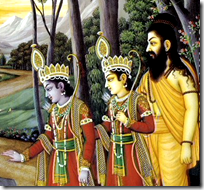 Rama and Lakshmana were beautiful in their appearance and also in their behavior. They didn’t complain about going with Vishvamitra. They were happy to protect the priestly class, an obligation vital to their order. They were descendants of King Raghu, so they were sometimes addressed as Raghava. They were taught from birth to follow righteousness and to always respect the brahmanas, who eschew material life in favor of worshiping God and teaching others how to follow that worship through the execution of their assigned duties. Seeing the boys carrying their bows and arrows and happily following Vishvamitra, the hearts of the residents just melted. Children are the essence of innocence, so when they take up serious tasks the sincerity of purpose is revealed. There were no ulterior motives in Rama and Lakshmana. They operated out of love only. Rama and Lakshmana were beautiful in their appearance and also in their behavior. They didn’t complain about going with Vishvamitra. They were happy to protect the priestly class, an obligation vital to their order. They were descendants of King Raghu, so they were sometimes addressed as Raghava. They were taught from birth to follow righteousness and to always respect the brahmanas, who eschew material life in favor of worshiping God and teaching others how to follow that worship through the execution of their assigned duties. Seeing the boys carrying their bows and arrows and happily following Vishvamitra, the hearts of the residents just melted. Children are the essence of innocence, so when they take up serious tasks the sincerity of purpose is revealed. There were no ulterior motives in Rama and Lakshmana. They operated out of love only.
It is difficult to accurately describe God’s beauty, so the kind poet Tulsidas has here made a very nice comparison. Lord Vishnu is the origin of life and matter, but the specific faculties for creating are invested in Lord Brahma. If we see something possessing natural beauty, it is to be understood that it is the handiwork of the creator, Brahma. But with God such references to Brahma’s creating ability only relate to appearance, as Rama and Lakshmana’s bodies are not created. There is no difference between spirit and matter for God or His plenary expansions like Lakshmana. Nevertheless the comparisons are made in an attempt to describe what an onlooker might think.
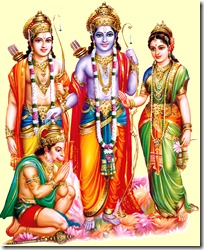 Tulsidas says that it looked like Brahma had taken all of the beauty in the world and placed it into Rama and Lakshmana. This is a nice form of flattery in one sense, but a true statement at the same time. Rama is the owner of matter, so His spiritual features represent the height of all opulence. As Bhagavan, He possesses beauty, wealth, strength, fame, renunciation and wisdom simultaneously and to the fullest extent. He is not lacking in anything. Lakshmana, Rama’s constant companion, is the servitor-God, so he has the same features to an almost identical level. Tulsidas says that it looked like Brahma had taken all of the beauty in the world and placed it into Rama and Lakshmana. This is a nice form of flattery in one sense, but a true statement at the same time. Rama is the owner of matter, so His spiritual features represent the height of all opulence. As Bhagavan, He possesses beauty, wealth, strength, fame, renunciation and wisdom simultaneously and to the fullest extent. He is not lacking in anything. Lakshmana, Rama’s constant companion, is the servitor-God, so he has the same features to an almost identical level.
This would not be the only time Tulsidas would use such a comparison. Similar kinds of statements are found in passages describing Rama’s future wife, Sita Devi. The two youths following Vishvamitra would eventually cause that union to take place on earth, though Sita and Rama are forever together in the spiritual sky. Pretty soon thereafter, the fourth piece of the group, Shri Hanuman, would join. Rama therefore never leaves the worshiper alone. If you honor Him then you get to bask in the sweet vision of Lakshmana, Sita and Hanuman as well. With those four beauties giving pleasure to the eyes, what more could anyone ask for?
In Closing:
Lord Brahma, all elements does he take,
To carry out his duty to create.
From the observer’s point of view,
All beauty Brahma must have used.
To craft bodies of Rama and Lakshmana the brother,
Their beauty out of this world, like no other.
Rama of skin dark and Lakshmana was fair,
Combination caused pleased eyes to stare.
To the forest with Vishvamitra were they sent,
Taking beauty with them, away the brothers went.
|
Search This Blog
Friday, March 23, 2012
Shyama-Gaura
Subscribe to:
Post Comments (Atom)
No comments:
Post a Comment